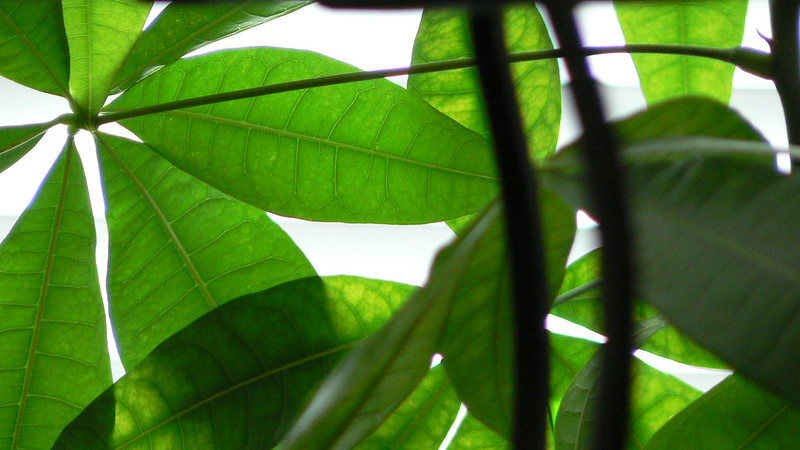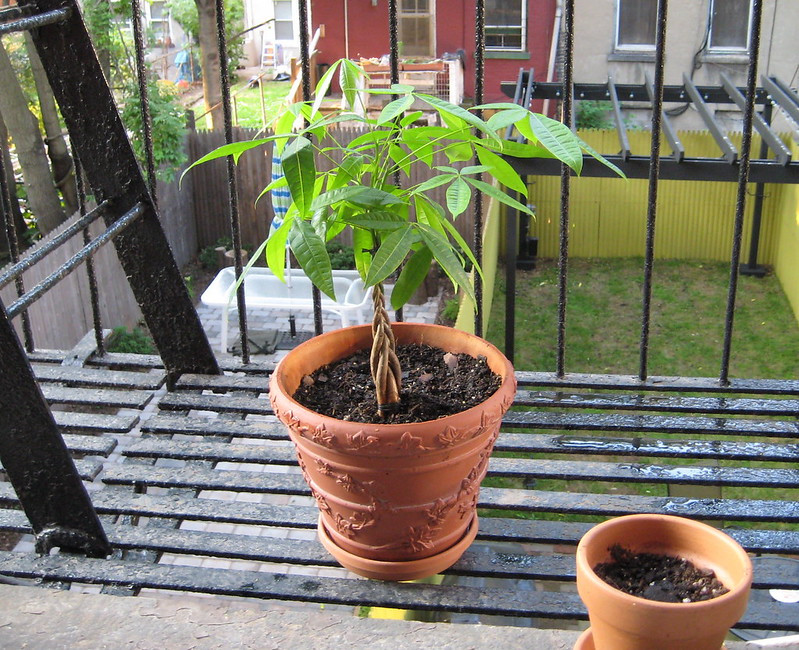The Pachira Aquatica Money Tree, also known as the Malabar chestnut or Guiana chestnut, is a popular houseplant celebrated for its ease of care and attractive appearance. Originating from the tropical wetlands of Central and South America, this plant brings a touch of lush greenery indoors. In homes, these adaptable plants typically reach heights of 3 to 6 feet, showcasing slender, woody stems crowned with distinctive whorls of compound leaves. Often, you’ll find money trees sold with multiple trunks braided together, creating a fuller, more tree-like silhouette that enhances their ornamental appeal.
 Pachira aquatica (money plant); photo courtesy of flickrcc/ Rick kimpel
Pachira aquatica (money plant); photo courtesy of flickrcc/ Rick kimpel
While the money tree Pachira aquatica is known for being low-maintenance and resilient under varied conditions, understanding its tropical wetland origins is key to successful cultivation. By mimicking its native environment in terms of moisture, humidity, and light, you can establish a routine that allows your Pachira money tree to flourish.
Optimal Light Conditions for Your Pachira Money Tree
Pachira aquatica money trees thrive in bright, indirect light, reminiscent of their natural habitat where taller trees filter the intense sunlight. While they can tolerate some shade and continue to grow, optimal health and vibrancy are achieved with ample filtered light. Ideally, position your money tree plant in a room that enjoys sunlight for a significant portion of the day, but avoid placing it directly in a window where harsh, direct sun can cause leaf burn.
Although money trees are adaptable to less-than-ideal lighting, prolonged periods in poor light can lead to a decline in health and loss of their characteristic lushness. To ensure balanced growth, rotate your Pachira aquatica each time you water it, promoting even light exposure to all sides of the plant.
Watering and Humidity Needs of Pachira Aquatica
Watering your Pachira money tree correctly involves mimicking its natural cycle of heavy rains followed by periods of dryness. It requires a consistent routine of moderate moisture. Plant your money tree in a pot with a drainage hole and use a well-draining potting mix to prevent waterlogging. Water thoroughly until the soil is moist, then allow any excess water to drain away. After about 15 minutes, discard any water that has accumulated in the plant’s saucer to avoid root rot.
Allow the topsoil to become nearly dry between waterings, but be careful not to let the roots completely dry out. It’s crucial to ensure the soil rehydrates effectively with each watering, but always lean towards slightly drier conditions rather than overwatering. A water meter probe can be a helpful tool to accurately measure moisture levels near the roots of your money tree Pachira aquatica.
Seasonal changes, particularly in winter, can affect how quickly the soil dries out. Drier indoor air from heating systems may lead to faster drying, while reduced daylight hours can slow down water evaporation. Adjust your watering schedule accordingly to match these changes.
In addition to proper watering, Pachira aquatica benefits from humidity levels around 50%. To increase humidity, especially during dry winter months, place your money tree on a tray filled with wet pebbles. As the water evaporates, it will create a humid microclimate around the plant, helping to prevent leaves from becoming crispy.
Ideal Temperature Range for a Healthy Money Tree
As tropical plants, Pachira money trees flourish in warm household temperatures, ideally between 65 and 85°F (18 to 29°C). Position your plant in a location with good air circulation, away from drafts from windows or air conditioning vents, and also avoid placing it near heating vents that can produce drying heat. Money trees are sensitive to sudden environmental changes, which can cause leaf drop. Maintaining a stable temperature is crucial for their well-being.
Re-potting Your Pachira Aquatica Money Tree
Repotting your Pachira aquatica money tree every two to three years is essential to provide it with fresh nutrients and space for root growth. The best time to repot is in the spring, coinciding with the start of the growing season. Choose a new pot that is only one size larger than the current one and ensure it has a drainage hole.
Use a high-quality houseplant potting mix that is designed to retain moisture while also providing good drainage. You can also create your own mix using equal parts organic compost, coarse builder’s sand or perlite, and a bit of peat or cocoa fiber for added water retention.
When repotting, handle the roots with care to minimize disturbance, as money trees are prone to leaf drop if their roots are excessively disturbed. If leaf drop does occur after repotting, don’t worry – with consistent care, new leaves should emerge during the next growth cycle.
Providing Nutrition to Your Money Tree
To maintain the vigor of your Pachira money tree, provide it with balanced, organic fertilizer at half strength every two weeks during the active growing season, which typically runs from March to September. Fertilizing during the dormant months is not necessary.
Pruning and Shaping Your Pachira Aquatica
Regular pruning helps maintain the shape and health of your Pachira money tree. Dead branches or leaves can be removed at any time using sharp, sterile pruning shears, cutting back to healthy wood several inches below the dead section. You can also trim new stems that sprout from the base or along the trunk to maintain the desired shape.
For more significant shaping and tidying, prune your money tree houseplant in the spring when it is entering a period of strong growth. Pruning during this time of active growth minimizes stress on the plant. Avoid pruning unhealthy plants, as it can add further stress. To maintain size and shape, annual pruning is beneficial.
When pruning for shape, examine your plant and decide which areas need trimming. Use sharp, sterile shears and cut stems up to ½ inch above a node or leaf, removing no more than half the length of any stem. Never cut into a braided section of the stems. New growth will typically emerge from the pruned areas.
Common Issues to Watch For with Your Money Tree
Leaf Drop: Money trees are particularly sensitive to root disturbance and environmental changes. Moving your plant to a new location or exposing it to drafts or temperature fluctuations can trigger leaf drop. If leaf drop occurs, assess the environment and correct any issues. Typically, leaves will regrow with the next growth cycle.
Seasonal Leaf Yellowing: Yellowing and dropping leaves in autumn can be a natural response to shorter days and reduced light. Increase light exposure if possible. As with leaf drop from disturbance, new leaves should reappear with increased light and the return of the growing season.
Crispy Leaves: Crispy, curling, and falling leaves often indicate low humidity, especially in winter, insufficient light, or inconsistent watering. Review and adjust these care aspects to improve conditions.
Yellowing Leaves and Stem Rot: Yellowing leaves accompanied by stem rot are usually signs of overwatering, water splashing on the stem, or poorly draining soil. Ensure your pot has a drainage hole and remove any standing water after watering. Allow the soil to dry out more between waterings.
Scale Insects: Scale insects are a common pest for money trees. Regularly inspect your plant, especially in crevices along stems and leaves. If you find scale, isolate the plant to prevent spread to other plants. Treat scale by gently loosening them with a cotton swab dipped in rubbing alcohol and then spraying or wiping them away. Consistent weekly checks and repeated treatments are crucial for controlling scale infestations.
 Pachira aquatica (money plant) with a braided stem; photo courtesy of Flickr cc/ Carlor Cabanilla
Pachira aquatica (money plant) with a braided stem; photo courtesy of Flickr cc/ Carlor Cabanilla
By understanding and addressing the specific needs of your Pachira aquatica money tree, you can enjoy a thriving, lush indoor plant that brings a touch of the tropics to your home.
